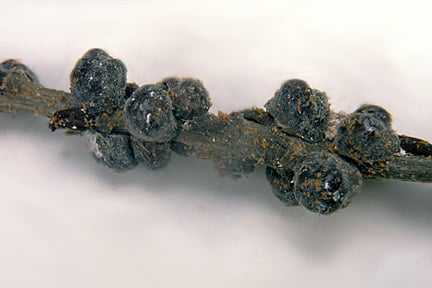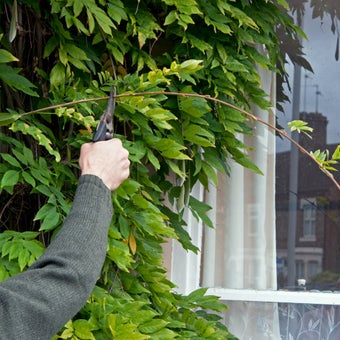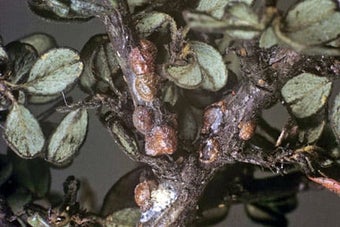
Quick facts
Common name - Wisteria scale
Scientific name - Eulecanium excrescens
Plants affected - Wisteria and some Prunus and Acer species
Main symptoms - Large, blackish-brown, hemispherical scales on stems.
Most active - April-June
What is wisteria scale?
Scale insects are sucking true bugs belonging to several families in the Hemiptera. Typically the adults are immobile having a flattened or raised appearance, with no visible legs. They often look like a ‘scale’ on a leaf or stem, many species produce a white wax often covering egg masses. There are more than 100 species found in Britain, 26 of which have been introduced. More than 25 species can be found in gardens or on houseplants.
At up to 10 mm in diameter wisteria scale is substantially larger than most other scale insects found in Britain. Wisteria scale mainly occurs on wisteria but also feeds on some Acer and Prunus species.

Symptoms
The mature scales are found in late spring on the stems of wisteria and other host plants. The shell or scale that covers the insect and its eggs is blackish brown usually with a whitish dusting. It has a circular base and hemispherical shape. Wisteria scale can be up to 10 mm in diameter, substantially larger than most other scale insects found in Britain. The immature scales are less convex and are pale brown with pinkish-white encrustations that resemble sugar grains. Wisteria scale can develop very heavy infestations and stems can become thickly encrusted with scales, when this occurs host plants may lack vigour and die back.
Note that there are other scale insects commonly found on wisteria. The most common is brown scale, Parthenolecanium corni, which is widespread in Britain on a wide range of woody plants. Brown scale is chestnut brown and oval in shape at the base. The mature scales can be up to 6 mm long but are often smaller. Nut scale, Eulecanium tiliae, has a similar hemispherical shape to wisteria scale but is brown and no more than 5-6 mm in diameter. Brown scale and nut scale are generally not damaging on wisteria.
Management
- Where possible tolerate populations of scale insects. Well-tended healthy plants are able to tolerate light populations of these insects and so they do not necessarily require management
- Encourage predators in the garden, some ladybirds, parasitoid wasps and some birds will eat scale insects
- Adult scales can be removed when seen but this may not reduce large populations
Biology
Wisteria scale has one generation a year. The mature females deposit their eggs underneath their shells in late spring. The eggs hatch in late May-June and the young nymphs crawl about until they find somewhere suitable to feed. After that they live sedentary lives. They overwinter as immature nymphs on the stems and reach maturity in late spring. Scale insects do not fly. It is likely that they spread to other plants by young nymphs being blown by the wind or being transported by other animals, such as birds.














